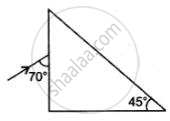Advertisements
Advertisements
Question
If a light ray does not undergo, refraction at the boundary between two media, the angle of incidence is:
Options
0°
45°
60°
90°
Solution
0°
APPEARS IN
RELATED QUESTIONS
Name the factors affecting the critical angle for the pair of media.
(i) Define critical angle.
(ii) State one important factor which affects the critical angle of a given medium.
Images formed by totally reflecting prisms are brighter than the image formed by ordinary reflected light, why?
Draw a diagram, properly labelled, to illustrate the use of a total reflecting prism (a right-angled isosceles prism) to turn a ray of light through 180°. Name an instrument in which this device is used.
Complete the following diagram to show the path of the ray of a single colour in the diagram as if enters in and emerges out of the prism. Mark the angles wherever necessary. (Critical angle for glass = 42°).

Answer the following question.
Describe the construction and working of an optical fibre.
Which one of the following is NOT the correct formula for refractive index of glass w.r.t. air (aμg) (i = angle of incidence, r = angle of refraction)
For total internal reflection to take place, the angle of inddence i and the refractive index µ of the medium must satisfy the inequality ____________.
The entire light is reflected back into the denser medium is called ______.
A light is entering from one medium refractive index `("RI" =5/3)` to another medium at an angle 30°. The angle of refraction for other medium is sin-1 `(5/6)`. then the increase in angle of incidence is ______ such that the ray of light reflected back into the same medium.
